 Atmospheric and Climate Sciences, 2011, 1, 134-141 doi:10.4236/acs.2011.13015 Published Online July 2011 (http://www.scirp.org/journal/acs) Copyright © 2011 SciRes. ACS Preliminary Meteorological Results of a Four-Dimensional Data Assimilation Technique in Southern Italy Elenio Avolio1*, S. Federico1, A. M. Sempreviva1, C. R. Calidonna1, L. De Leo1, C. Bellecci2,3 1ISAC-CNR, Lamezia Terme, Italy 2CRATI Scrl, c/o University of Calabria, Rende, Italy 3University of Rome “Tor Vergata”, Depa rt ment STFE, Rome, Italy E-mail: e.avolio@isac.cnr.it Received April 27, 2011; revised June 3, 2011; accepted J une 18, 2011 Abstract A four-dimensional data assimilation (FDDA) scheme based on a Newtonian relaxation (or “nudging”) was tested using observational asynoptic data collected at a coastal site in the Central Mediterranean peninsula of Calabria, southern Italy. The study is referred to an experimental campaign carried out in summer 2008. For this period a wind profiler, a sodar and two surface meteorological stations were considered. The collected measurements were used for the FDDA scheme, and the technique was incorporated into a tailored version of the Regional Atmospheric Modeling System (RAMS). All instruments are installed and operated routinely at the experimental field of the CRATI-ISAC/CNR located at 600 m from the Tyrrhenian coastline. Several simulations were performed, and the results show that the assimilation of wind and/or temperature data, both throughout the simulation time (continuous FDDA) and for a 12 h time window (forecasting configuration), produces improvements of the model performance. Considering a whole single day, improvements are sub- stantial in the case of continuous FDDA while they are smaller in the case of forecasting configuration. En- hancements, during the first six hours of each run, are generally higher. The resulting meteorological fields are finalised as input into air quality and agro-meteorological models, for short-term predictions of renew- able energy production forecast, and for atmospheric model initialization. Keywords: Data Assimilation, Short Term Forecast, Mesoscale Model Performance 1. Introduction A particularly crucial issue for improving mesoscale nu- merical models is the improvement of knowledge of the atmospheric state through the use of available data, in order to produce good initial and boundary conditions. Several instruments, such as profilers, sodars, radars, satellite systems and surface meteorological stations, are able to provide continuous streams of data on evolving atmospheric conditions, and also provide spatial informa- tion in vertical or horizontal space. Data assimilation is the procedure that consists to in- corporate observational data into analysis or forecast provided by meteorological model [1]. Four Dimensional Data Assimilation (FDDA), based on Newtonian Relaxation (or nudging) [2,3], is a useful and relatively simple data assimilation technique to pro- duce accurate meteorological simulations. Nudging adds an extra tendency term to the prognostic equation of the assimilated variable, and forces the predicted variable towards the available observations. Since nudging is performed toward observations, the technique is referred to as “observational data assimilation (ODA)” Several studies, referred to the regional and local scales, have shown that FDDA, on average, can reduce errors by about 25 - 60%, depending on the cases [4-7]. In this sense, the most common problem is to obtain an independent data set for effective validation of diagnostic models [8]. Recent studies describe experiments were verification data differ from those used for assimilation. In Tanrikulu et al. [9] and in Michelson and Seaman [10] is used the data withholding technique. Also Nielsen-Gammon et al. [11], more recently, use this approach of validation. Um- eda and Martien [12] use different data set for verifica- tion, and Barna and Lamb [13] perform an indirect veri- fication, analyzing the final results of air quality simula- tions. 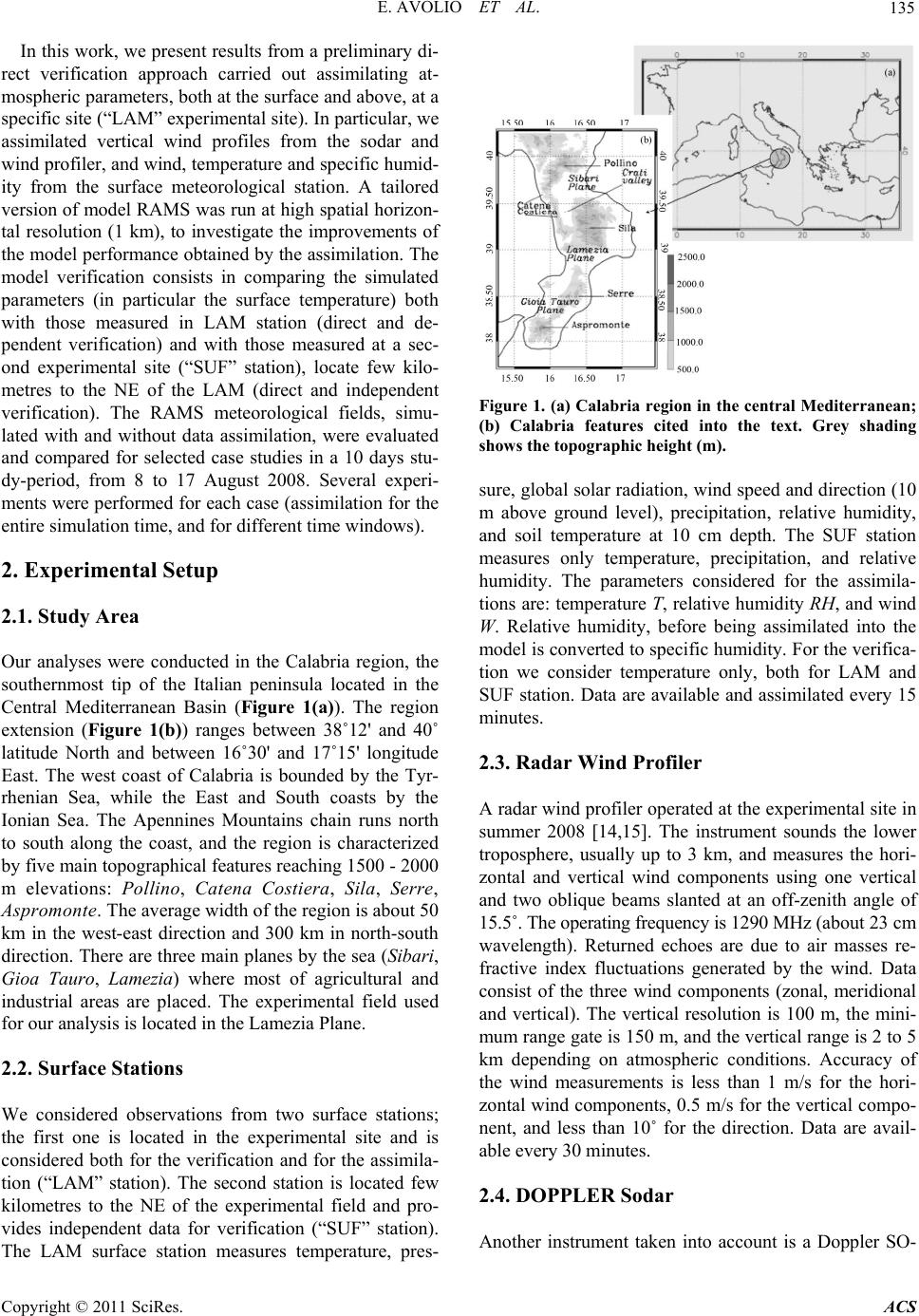 E. AVOLIO ET AL. 135 In this work, we present results from a preliminary di- rect verification approach carried out assimilating at- mospheric parameters, both at the surface and above, at a specific site (“LAM” experimental site). In particular, we assimilated vertical wind profiles from the sodar and wind profiler, and wind, temperature and specific humid- ity from the surface meteorological station. A tailored version of model RAMS was run at high spatial horizon- tal resolution (1 km), to investigate the improvements of the model performance obtained by the assimilation. The model verification consists in comparing the simulated parameters (in particular the surface temperature) both with those measured in LAM station (direct and de- pendent verification) and with those measured at a sec- ond experimental site (“SUF” station), locate few kilo- metres to the NE of the LAM (direct and independent verification). The RAMS meteorological fields, simu- lated with and without data assimilation, were evaluated and compared for selected case studies in a 10 days stu- dy-period, from 8 to 17 August 2008. Several experi- ments were performed for each case (assimilation for the entire simulation time, and for different time windows). 2. Experimental Setup 2.1. Study Area Our analyses were conducted in the Calabria region, the southernmost tip of the Italian peninsula located in the Central Mediterranean Basin (Figure 1(a)). The region extension (Figure 1(b)) ranges between 38˚12' and 40˚ latitude North and between 16˚30' and 17˚15' longitude East. The west coast of Calabria is bounded by the Tyr- rhenian Sea, while the East and South coasts by the Ionian Sea. The Apennines Mountains chain runs north to south along the coast, and the region is characterized by five main topographical features reaching 1500 - 2000 m elevations: Pollino, Catena Costiera, Sila, Serre, Aspromonte. The average width of the region is about 50 km in the west-east direction and 300 km in north-south direction. There are three main planes by the sea (Sibari, Gioa Tauro, Lamezia) where most of agricultural and industrial areas are placed. The experimental field used for our analysis is located in the Lamezia Plane. 2.2. Surface Stations We considered observations from two surface stations; the first one is located in the experimental site and is considered both for the verification and for the assimila- tion (“LAM” station). The second station is located few kilometres to the NE of the experimental field and pro- vides independent data for verification (“SUF” station). The LAM surface station measures temperature, pres- Figure 1. (a) Calabria region in the central Mediterranean; (b) Calabria features cited into the text. Grey shading shows the topographic height (m). sure, global solar radiation, wind speed and direction (10 m above ground level), precipitation, relative humidity, and soil temperature at 10 cm depth. The SUF station measures only temperature, precipitation, and relative humidity. The parameters considered for the assimila- tions are: temperature T, relative humidity RH, and wind W. Relative humidity, before being assimilated into the model is converted to specific humidity. For the verifica- tion we consider temperature only, both for LAM and SUF station. Data are available and assimilated every 15 minutes. 2.3. Radar Wind Profiler A radar wind profiler operated at the experimental site in summer 2008 [14,15]. The instrument sounds the lower troposphere, usually up to 3 km, and measures the hori- zontal and vertical wind components using one vertical and two oblique beams slanted at an off-zenith angle of 15.5˚. The operating frequency is 1290 MHz (about 23 cm wavelength). Returned echoes are due to air masses re- fractive index fluctuations generated by the wind. Data consist of the three wind components (zonal, meridional and vertical). The vertical resolution is 100 m, the mini- mum range gate is 150 m, and the vertical range is 2 to 5 km depending on atmospheric conditions. Accuracy of the wind measurements is less than 1 m/s for the hori- zontal wind components, 0.5 m/s for the vertical compo- nent, and less than 10˚ for the direction. Data are avail- able every 30 minutes. 2.4. DOPPLER Sodar Another instrument taken into account is a Doppler SO- Copyright © 2011 SciRes. ACS 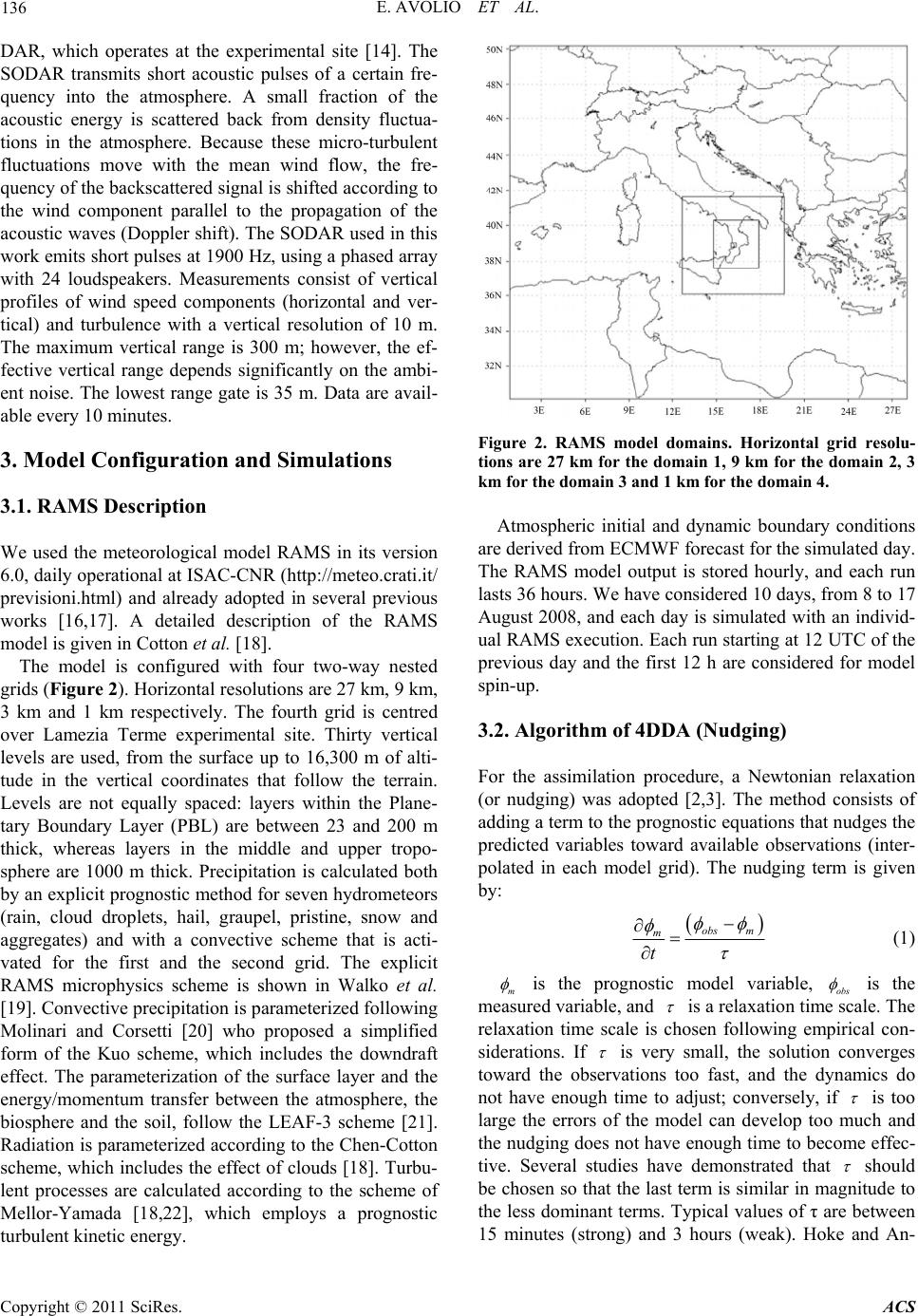 136 E. AVOLIO ET AL. DAR, which operates at the experimental site [14]. The SODAR transmits short acoustic pulses of a certain fre- quency into the atmosphere. A small fraction of the acoustic energy is scattered back from density fluctua- tions in the atmosphere. Because these micro-turbulent fluctuations move with the mean wind flow, the fre- quency of the backscattered signal is shifted according to the wind component parallel to the propagation of the acoustic waves (Doppler shift). The SODAR used in this work emits short pulses at 1900 Hz, using a phased array with 24 loudspeakers. Measurements consist of vertical profiles of wind speed components (horizontal and ver- tical) and turbulence with a vertical resolution of 10 m. The maximum vertical range is 300 m; however, the ef- fective vertical range depends significantly on the ambi- ent noise. The lowest range gate is 35 m. Data are avail- able every 10 minutes. 3. Model Configuration and Simulations 3.1. RAMS Description We used the meteorological model RAMS in its version 6.0, daily operational at ISAC-CNR (http://meteo.crati.it/ previsioni.html) and already adopted in several previous works [16,17]. A detailed description of the RAMS model is given in Cotton et al. [18]. The model is configured with four two-way nested grids (Figure 2). Horizontal resolutions are 27 km, 9 km, 3 km and 1 km respectively. The fourth grid is centred over Lamezia Terme experimental site. Thirty vertical levels are used, from the surface up to 16,300 m of alti- tude in the vertical coordinates that follow the terrain. Levels are not equally spaced: layers within the Plane- tary Boundary Layer (PBL) are between 23 and 200 m thick, whereas layers in the middle and upper tropo- sphere are 1000 m thick. Precipitation is calculated both by an explicit prognostic method for seven hydrometeors (rain, cloud droplets, hail, graupel, pristine, snow and aggregates) and with a convective scheme that is acti- vated for the first and the second grid. The explicit RAMS microphysics scheme is shown in Walko et al. [19]. Convective precipitation is parameterized following Molinari and Corsetti [20] who proposed a simplified form of the Kuo scheme, which includes the downdraft effect. The parameterization of the surface layer and the energy/momentum transfer between the atmosphere, the biosphere and the soil, follow the LEAF-3 scheme [21]. Radiation is parameterized according to the Chen-Cotton scheme, which includes the effect of clouds [18]. Turbu- lent processes are calculated according to the scheme of Mellor-Yamada [18,22], which employs a prognostic turbulent kinetic energy. Figure 2. RAMS model domains. Horizontal grid resolu- tions are 27 km for the domain 1, 9 km for the domain 2, 3 km for the domain 3 and 1 km for the domain 4. Atmospheric initial and dynamic boundary conditions are derived from ECMWF forecast for the simulated day. The RAMS model output is stored hourly, and each run lasts 36 hours. We have considered 10 days, from 8 to 17 August 2008, and each day is simulated with an individ- ual RAMS execution. Each run starting at 12 UTC of the previous day and the first 12 h are considered for model spin-up. 3.2. Algorithm of 4DDA (Nudging) For the assimilation procedure, a Newtonian relaxation (or nudging) was adopted [2,3]. The method consists of adding a term to the prognostic equations that nudges the predicted variables toward available observations (inter- polated in each model grid). The nudging term is given by: obs m m t (1) m is the prognostic model variable, obs is the measured variable, and is a relaxation time scale. The relaxation time scale is chosen following empirical con- siderations. If is very small, the solution converges toward the observations too fast, and the dynamics do not have enough time to adjust; conversely, if is too large the errors of the model can develop too much and the nudging does not have enough time to become effec- tive. Several studies have demonstrated that should be chosen so that the last term is similar in magnitude to the less dominant terms. Typical values of τ are between 15 minutes (strong) and 3 hours (weak). Hoke and An- Copyright © 2011 SciRes. ACS 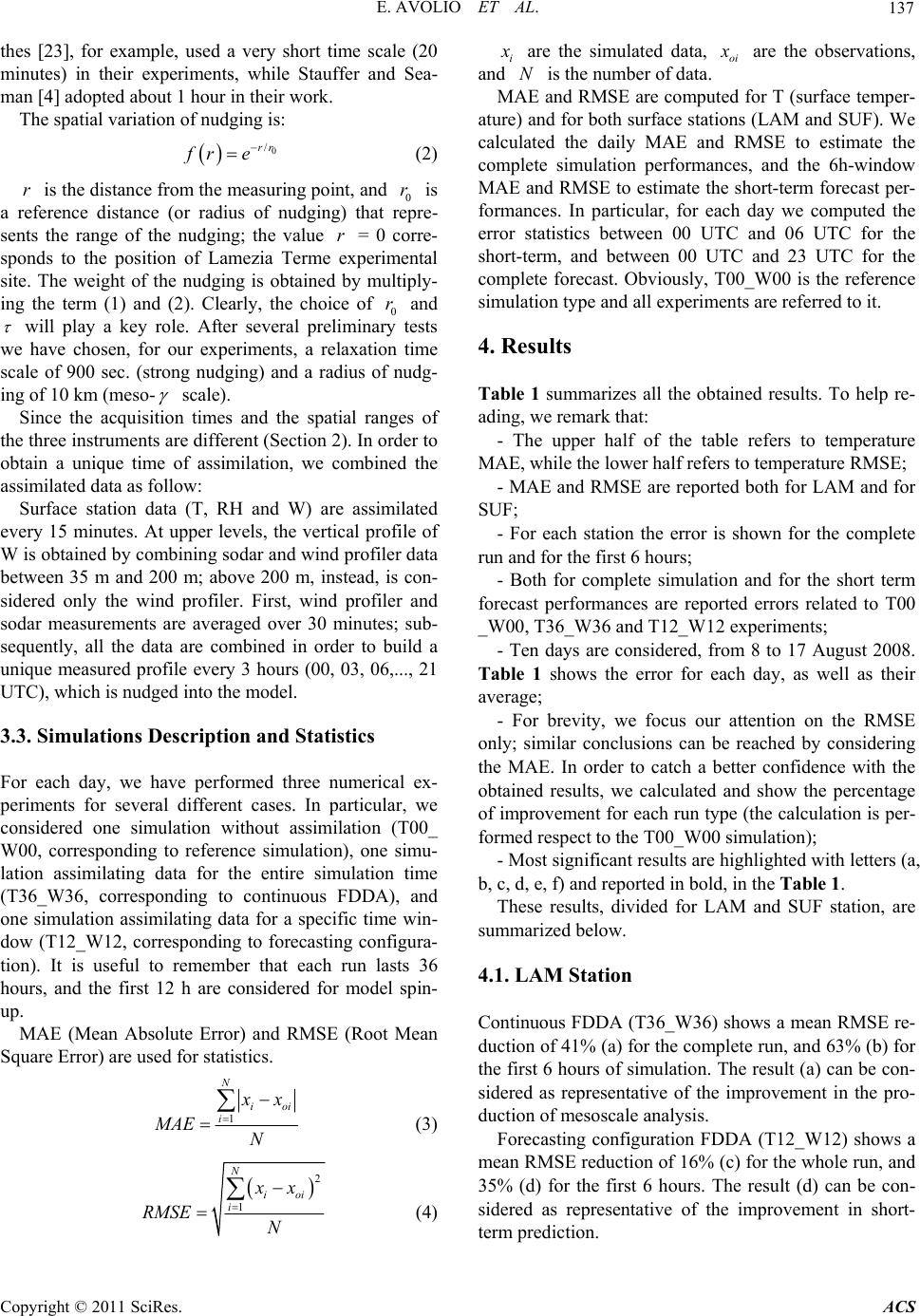 E. AVOLIO ET AL. 137 thes [23], for example, used a very short time scale (20 minutes) in their experiments, while Stauffer and Sea- man [4] adopted about 1 hour in their work. The spatial variation of nudging is: 0 /rr fr e (2) r is the distance from the measuring point, and 0 is a reference distance (or radius of nudging) that repre- sents the range of the nudging; the value = 0 corre- sponds to the position of Lamezia Terme experimental site. The weight of the nudging is obtained by multiply- ing the term (1) and (2). Clearly, the choice of 0 and r r r will play a key role. After several preliminary tests we have chosen, for our experiments, a relaxation time scale of 900 sec. (strong nudging) and a radius of nudg- ing of 10 km (meso- scale). Since the acquisition times and the spatial ranges of the three instruments are different (Section 2). In order to obtain a unique time of assimilation, we combined the assimilated data as follow: Surface station data (T, RH and W) are assimilated every 15 minutes. At upper levels, the vertical profile of W is obtained by combining sodar and wind profiler data between 35 m and 200 m; above 200 m, instead, is con- sidered only the wind profiler. First, wind profiler and sodar measurements are averaged over 30 minutes; sub- sequently, all the data are combined in order to build a unique measured profile every 3 hours (00, 03, 06,..., 21 UTC), which is nudged into the model. 3.3. Simulations Description and Statistics For each day, we have performed three numerical ex- periments for several different cases. In particular, we considered one simulation without assimilation (T00_ W00, corresponding to reference simulation), one simu- lation assimilating data for the entire simulation time (T36_W36, corresponding to continuous FDDA), and one simulation assimilating data for a specific time win- dow (T12_W12, corresponding to forecasting configura- tion). It is useful to remember that each run lasts 36 hours, and the first 12 h are considered for model spin- up. MAE (Mean Absolute Error) and RMSE (Root Mean Square Error) are used for statistics. 1 N ioi i x MAE N (3) 2 1 N ioi i xx RMSE N (4) i are the simulated data, oi are the observations, and is the number of data. N MAE and RMSE are computed for T (surface temper- ature) and for both surface stations (LAM and SUF). We calculated the daily MAE and RMSE to estimate the complete simulation performances, and the 6h-window MAE and RMSE to estimate the short-term forecast per- formances. In particular, for each day we computed the error statistics between 00 UTC and 06 UTC for the short-term, and between 00 UTC and 23 UTC for the complete forecast. Obviously, T00_W00 is the reference simulation type and all experiments are referred to it. 4. Results Table 1 summarizes all the obtained results. To help re- ading, we remark that: - The upper half of the table refers to temperature MAE, while the lower half refers to temperature RMSE; - MAE and RMSE are reported both for LAM and for SUF; - For each station the error is shown for the complete run and for the first 6 hours; - Both for complete simulation and for the short term forecast performances are reported errors related to T00 _W00, T36_W36 and T12_W12 experiments; - Ten days are considered, from 8 to 17 August 2008. Table 1 shows the error for each day, as well as their average; - For brevity, we focus our attention on the RMSE only; similar conclusions can be reached by considering the MAE. In order to catch a better confidence with the obtained results, we calculated and show the percentage of improvement for each run type (the calculation is per- formed respect to the T00_W00 simulation); - Most significant results are highlighted with letters (a, b, c, d, e, f) and reported in bold, in the Table 1. These results, divided for LAM and SUF station, are summarized below. 4.1. LAM Station Continuous FDDA (T36_W36) shows a mean RMSE re- duction of 41% (a) for the complete run, and 63% (b) for the first 6 hours of simulation. The result (a) can be con- sidered as representative of the improvement in the pro- duction of mesoscale analysis. Forecasting configuration FDDA (T12_W12) shows a mean RMSE reduction of 16% (c) for the whole run, and 35% (d) for the first 6 hours. The result (d) can be con- sidered as representative of the improvement in short- erm prediction. t Copyright © 2011 SciRes. ACS 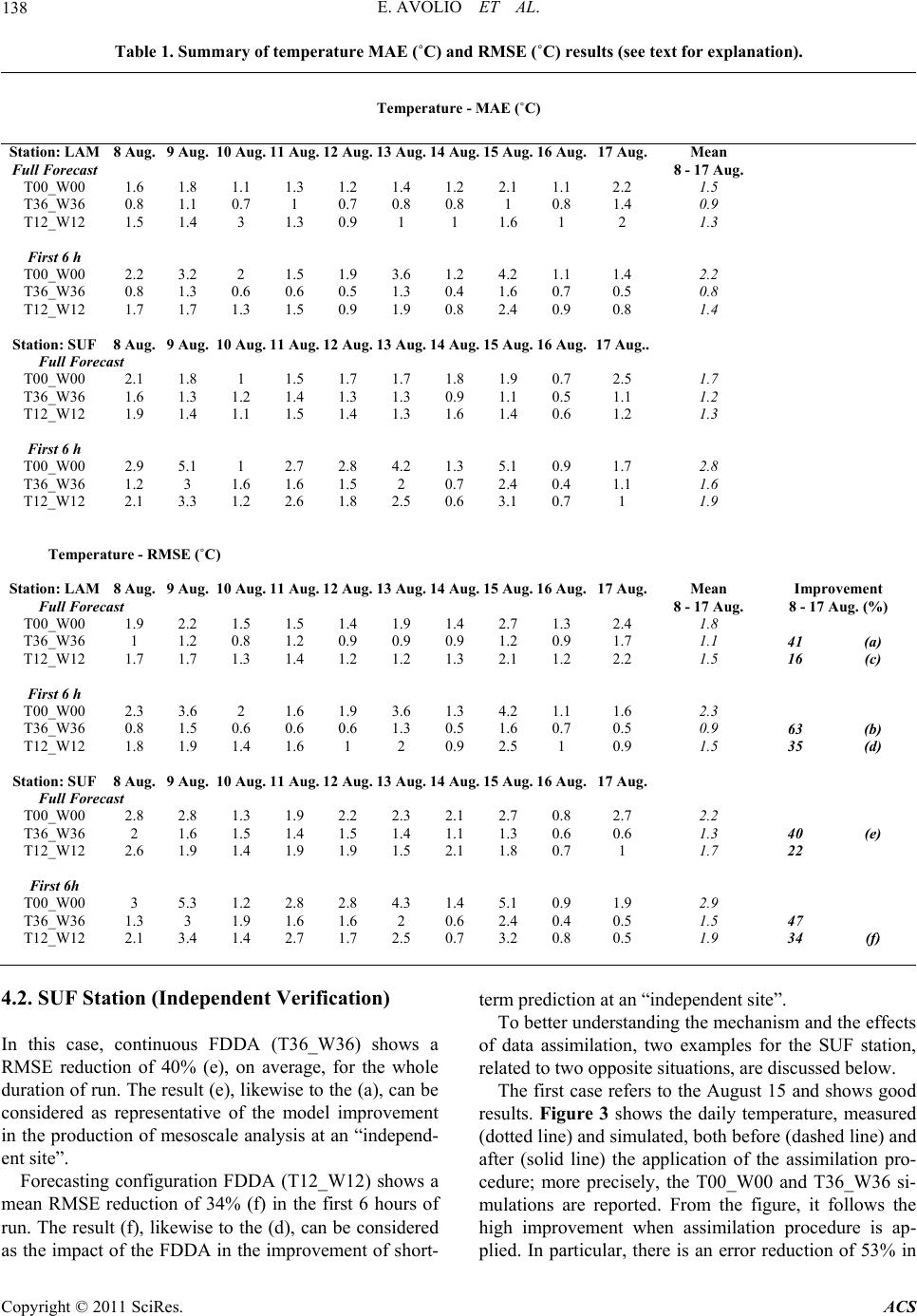 E. AVOLIO ET AL. Copyright © 2011 SciRes. ACS 138 Table 1. Summary of temperature MAE (˚C) and RMSE (˚C) results (see text for explanation). Temp eratur e - MAE (˚C) Station: LAM 8 Aug. 9 Aug. 10 Aug. 11 Aug. 12 Aug.13 Aug.14 Aug.15 Aug.16 Aug.17 Aug. Full Forecast Mean 8 - 17 Aug. T00_W00 1.6 1.8 1.1 1.3 1.2 1.4 1.2 2.1 1.1 2.2 1.5 T36_W36 0.8 1.1 0.7 1 0.7 0.8 0.8 1 0.8 1.4 0.9 T12_W12 1.5 1.4 3 1.3 0.9 1 1 1.6 1 2 1.3 First 6 h T00_W00 2.2 3.2 2 1.5 1.9 3.6 1.2 4.2 1.1 1.4 2.2 T36_W36 0.8 1.3 0.6 0.6 0.5 1.3 0.4 1.6 0.7 0.5 0.8 T12_W12 1.7 1.7 1.3 1.5 0.9 1.9 0.8 2.4 0.9 0.8 1.4 Station: SUF 8 Aug. 9 Aug. 10 Aug. 11 Aug. 12 Aug.13 Au g .14 Aug.15 Aug.16 Aug.17 A ug.. Full Forecast T00_W00 2.1 1.8 1 1.5 1.7 1.7 1.8 1.9 0.7 2.5 1.7 T36_W36 1.6 1.3 1.2 1.4 1.3 1.3 0.9 1.1 0.5 1.1 1.2 T12_W12 1.9 1.4 1.1 1.5 1.4 1.3 1.6 1.4 0.6 1.2 1.3 First 6 h T00_W00 2.9 5.1 1 2.7 2.8 4.2 1.3 5.1 0.9 1.7 2.8 T36_W36 1.2 3 1.6 1.6 1.5 2 0.7 2.4 0.4 1.1 1.6 T12_W12 2.1 3.3 1.2 2.6 1.8 2.5 0.6 3.1 0.7 1 1.9 Temperature - RMSE (˚C) Station: LAM 8 Aug. 9 Aug. 10 Aug. 11 Aug. 12 Aug.13 Aug.14 Aug.15 Aug.16 Aug.17 Aug. Full Forecast Mean 8 - 17 Aug. Improvement 8 - 17 Aug. (%) T00_W00 1.9 2.2 1.5 1.5 1.4 1.9 1.4 2.7 1.3 2.4 1.8 T36_W36 1 1.2 0.8 1.2 0.9 0.9 0.9 1.2 0.9 1.7 1.1 41 (a) T12_W12 1.7 1.7 1.3 1.4 1.2 1.2 1.3 2.1 1.2 2.2 1.5 16 (c) First 6 h T00_W00 2.3 3.6 2 1.6 1.9 3.6 1.3 4.2 1.1 1.6 2.3 T36_W36 0.8 1.5 0.6 0.6 0.6 1.3 0.5 1.6 0.7 0.5 0.9 63 (b) T12_W12 1.8 1.9 1.4 1.6 1 2 0.9 2.5 1 0.9 1.5 35 (d) Station: SUF 8 Aug. 9 Aug. 10 Aug. 11 Aug. 12 Aug.13 Aug.14 Aug.15 Aug.16 Aug.17 Aug. Full Forecast T00_W00 2.8 2.8 1.3 1.9 2.2 2.3 2.1 2.7 0.8 2.7 2.2 T36_W36 2 1.6 1.5 1.4 1.5 1.4 1.1 1.3 0.6 0.6 1.3 40 (e) T12_W12 2.6 1.9 1.4 1.9 1.9 1.5 2.1 1.8 0.7 1 1.7 22 First 6h T00_W00 3 5.3 1.2 2.8 2.8 4.3 1.4 5.1 0.9 1.9 2.9 T36_W36 1.3 3 1.9 1.6 1.6 2 0.6 2.4 0.4 0.5 1.5 47 T12_W12 2.1 3.4 1.4 2.7 1.7 2.5 0.7 3.2 0.8 0.5 1.9 34 (f) 4.2. SUF Station (Independent Verification) In this case, continuous FDDA (T36_W36) shows a RMSE reduction of 40% (e), on average, for the whole duration of run. The result (e), likewise to the (a), can be considered as representative of the model improvement in the production of mesoscale analysis at an “independ- ent site”. Forecasting configuration FDDA (T12_W12) shows a mean RMSE reduction of 34% (f) in the first 6 hours of run. The result (f), likewise to the (d), can be considered as the impact of the FDDA in the improvement of short- term prediction at an “independent site”. To better understanding the mechanism and the effects of data assimilation, two examples for the SUF station, related to two opposite situations, are discussed below. The first case refers to the August 15 and shows good results. Figure 3 shows the daily temperature, measured (dotted line) and simulated, both before (dashed line) and after (solid line) the application of the assimilation pro- cedure; more precisely, the T00_W00 and T36_W36 si- mulations are reported. From the figure, it follows the high improvement when assimilation procedure is ap- plied. In particular, there is an error reduction of 53% in 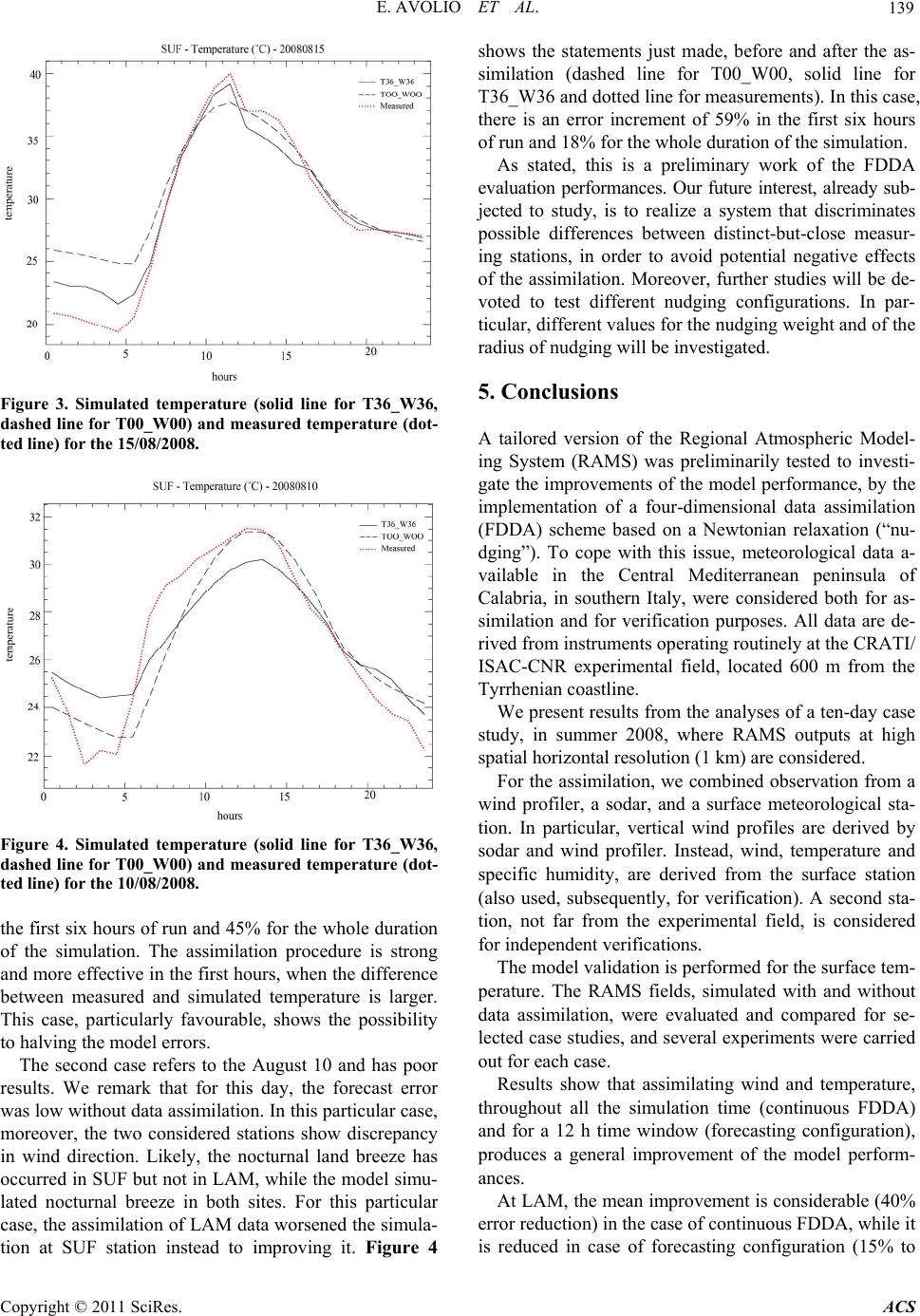 E. AVOLIO ET AL. 139 Figure 3. Simulated temperature (solid line for T36_W36, dashed line for T00_W00) and measured temperature (dot- ted line) for the 15/08/2008. Figure 4. Simulated temperature (solid line for T36_W36, dashed line for T00_W00) and measured temperature (dot- ted line) for the 10/08/2008. the first six hours of run and 45% for the whole duration of the simulation. The assimilation procedure is strong and more effective in the first hours, when the difference between measured and simulated temperature is larger. This case, particularly favourable, shows the possibility to halving the model errors. The second case refers to the August 10 and has poor results. We remark that for this day, the forecast error was low without data assimilation. In this particular case, moreover, the two considered stations show discrepancy in wind direction. Likely, the nocturnal land breeze has occurred in SUF but not in LAM, while the model simu- lated nocturnal breeze in both sites. For this particular case, the assimilation of LAM data worsened the simula- tion at SUF station instead to improving it. Figure 4 shows the statements just made, before and after the as- similation (dashed line for T00_W00, solid line for T36_W36 and dotted line for measurements). In this case, there is an error increment of 59% in the first six hours of run and 18% for the whole duration of the simulation. As stated, this is a preliminary work of the FDDA evaluation performances. Our future interest, already sub- jected to study, is to realize a system that discriminates possible differences between distinct-but-close measur- ing stations, in order to avoid potential negative effects of the assimilation. Moreover, further studies will be de- voted to test different nudging configurations. In par- ticular, different values for the nudging weight and of the radius of nudging will be investigated. 5. Conclusions A tailored version of the Regional Atmospheric Model- ing System (RAMS) was preliminarily tested to investi- gate the improvements of the model performance, by the implementation of a four-dimensional data assimilation (FDDA) scheme based on a Newtonian relaxation (“nu- dging”). To cope with this issue, meteorological data a- vailable in the Central Mediterranean peninsula of Calabria, in southern Italy, were considered both for as- similation and for verification purposes. All data are de- rived from instruments operating routinely at the CRATI/ ISAC-CNR experimental field, located 600 m from the Tyrrhenian coastline. We present results from the analyses of a ten-day case study, in summer 2008, where RAMS outputs at high spatial horizontal resolution (1 km) are considered. For the assimilation, we combined observation from a wind profiler, a sodar, and a surface meteorological sta- tion. In particular, vertical wind profiles are derived by sodar and wind profiler. Instead, wind, temperature and specific humidity, are derived from the surface station (also used, subsequently, for verification). A second sta- tion, not far from the experimental field, is considered for independent verifications. The model validation is performed for the surface tem- perature. The RAMS fields, simulated with and without data assimilation, were evaluated and compared for se- lected case studies, and several experiments were carried out for each case. Results show that assimilating wind and temperature, throughout all the simulation time (continuous FDDA) and for a 12 h time window (forecasting configuration), produces a general improvement of the model perform- ances. At LAM, the mean improvement is considerable (40% error reduction) in the case of continuous FDDA, while it is reduced in case of forecasting configuration (15% to Copyright © 2011 SciRes. ACS 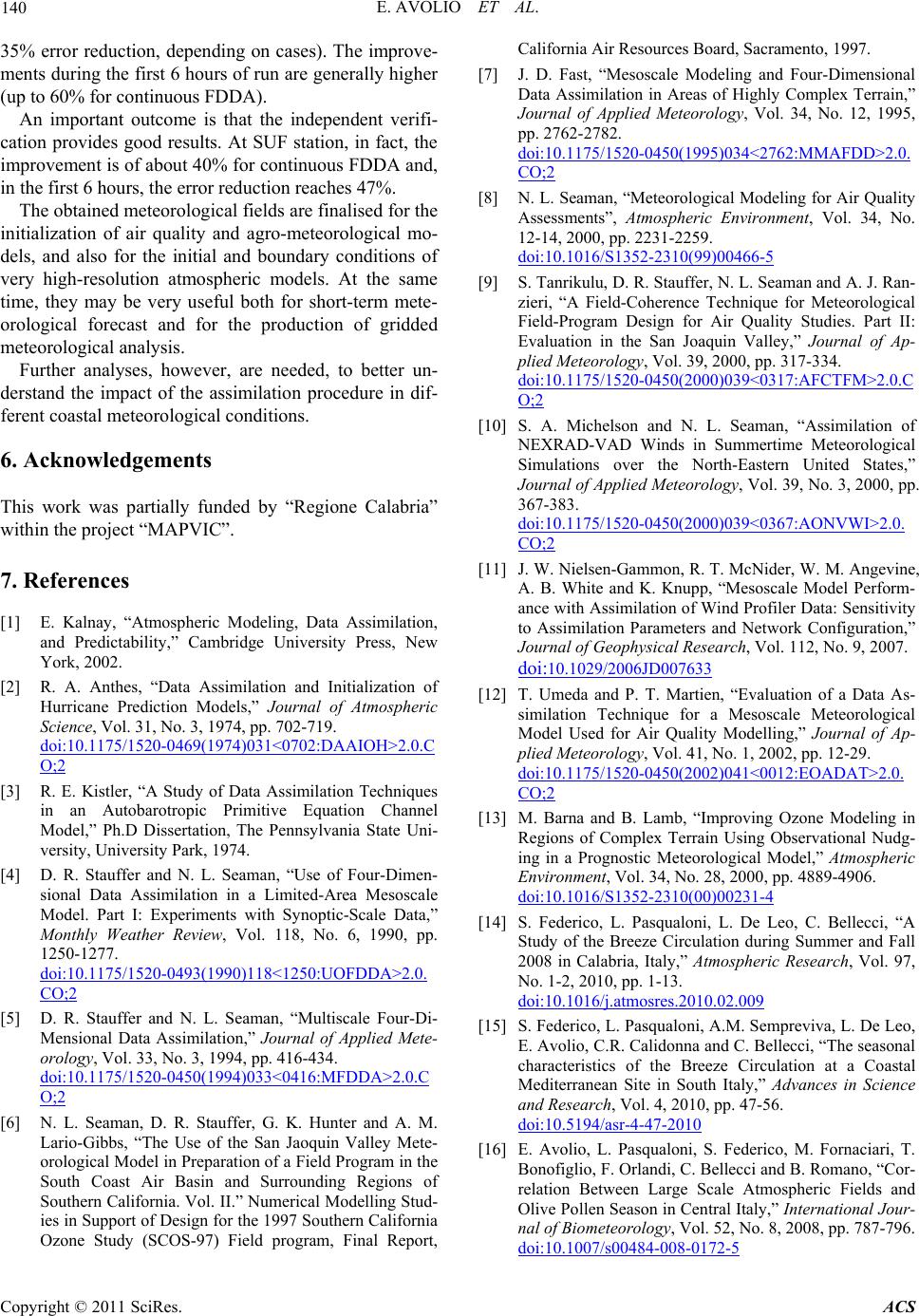 140 E. AVOLIO ET AL. 35% error reduction, depending on cases). The improve- ments during the first 6 hours of run are generally higher (up to 60% for continuous FDDA). An important outcome is that the independent verifi- cation provides good results. At SUF station, in fact, the improvement is of about 40% for continuous FDDA and, in the first 6 hours, the error reduction reaches 47%. The obtained meteorological fields are finalised for the initialization of air quality and agro-meteorological mo- dels, and also for the initial and boundary conditions of very high-resolution atmospheric models. At the same time, they may be very useful both for short-term mete- orological forecast and for the production of gridded meteorological analysis. Further analyses, however, are needed, to better un- derstand the impact of the assimilation procedure in dif- ferent coastal meteorological conditions. 6. Acknowledgements This work was partially funded by “Regione Calabria” within the project “MAPVIC”. 7. References [1] E. Kalnay, “Atmospheric Modeling, Data Assimilation, and Predictability,” Cambridge University Press, New York, 2002. [2] R. A. Anthes, “Data Assimilation and Initialization of Hurricane Prediction Models,” Journal of Atmospheric Science, Vol. 31, No. 3, 1974, pp. 702-719. doi:10.1175/1520-0469(1974)031<0702:DAAIOH>2.0.C O;2 [3] R. E. Kistler, “A Study of Data Assimilation Techniques in an Autobarotropic Primitive Equation Channel Model,” Ph.D Dissertation, The Pennsylvania State Uni- versity, University Park, 1974. [4] D. R. Stauffer and N. L. Seaman, “Use of Four-Dimen- sional Data Assimilation in a Limited-Area Mesoscale Model. Part I: Experiments with Synoptic-Scale Data,” Monthly Weather Review, Vol. 118, No. 6, 1990, pp. 1250-1277. doi:10.1175/1520-0493(1990)118<1250:UOFDDA>2.0. CO;2 [5] D. R. Stauffer and N. L. Seaman, “Multiscale Four-Di- Mensional Data Assimilation,” Journal of Applied Mete- orology, Vol. 33, No. 3, 1994, pp. 416-434. doi:10.1175/1520-0450(1994)033<0416:MFDDA>2.0.C O;2 [6] N. L. Seaman, D. R. Stauffer, G. K. Hunter and A. M. Lario-Gibbs, “The Use of the San Jaoquin Valley Mete- orological Model in Preparation of a Field Program in the South Coast Air Basin and Surrounding Regions of Southern California. Vol. II.” Numerical Modelling Stud- ies in Support of Design for the 1997 Southern California Ozone Study (SCOS-97) Field program, Final Report, California Air Resources Board, Sacramento, 1997. [7] J. D. Fast, “Mesoscale Modeling and Four-Dimensional Data Assimilation in Areas of Highly Complex Terrain,” Journal of Applied Meteorology, Vol. 34, No. 12, 1995, pp. 2762-2782. doi:10.1175/1520-0450(1995)034<2762:MMAFDD>2.0. CO;2 [8] N. L. Seaman, “Meteorological Modeling for Air Quality Assessments”, Atmospheric Environment, Vol. 34, No. 12-14, 2000, pp. 2231-2259. doi:10.1016/S1352-2310(99)00466-5 [9] S. Tanrikulu, D. R. Stauffer, N. L. Seaman and A. J. Ran- zieri, “A Field-Coherence Technique for Meteorological Field-Program Design for Air Quality Studies. Part II: Evaluation in the San Joaquin Valley,” Journal of Ap- plied Meteorology, Vol. 39, 2000, pp. 317-334. doi:10.1175/1520-0450(2000)039<0317:AFCTFM>2.0.C O;2 [10] S. A. Michelson and N. L. Seaman, “Assimilation of NEXRAD-VAD Winds in Summertime Meteorological Simulations over the North-Eastern United States,” Journal of Applied Meteorology, Vol. 39, No. 3, 2000, pp. 367-383. doi:10.1175/1520-0450(2000)039<0367:AONVWI>2.0. CO;2 [11] J. W. Nielsen-Gammon, R. T. McNider, W. M. Angevine, A. B. White and K. Knupp, “Mesoscale Model Perform- ance with Assimilation of Wind Profiler Data: Sensitivity to Assimilation Parameters and Network Configuration,” Journal of Geophysical Research, Vol. 112, No. 9, 2007. doi:10.1029/2006JD007633 [12] T. Umeda and P. T. Martien, “Evaluation of a Data As- similation Technique for a Mesoscale Meteorological Model Used for Air Quality Modelling,” Journal of Ap- plied Meteorology, Vol. 41, No. 1, 2002, pp. 12-29. doi:10.1175/1520-0450(2002)041<0012:EOADAT>2.0. CO;2 [13] M. Barna and B. Lamb, “Improving Ozone Modeling in Regions of Complex Terrain Using Observational Nudg- ing in a Prognostic Meteorological Model,” Atmospheric Environment, Vol. 34, No. 28, 2000, pp. 4889-4906. doi:10.1016/S1352-2310(00)00231-4 [14] S. Federico, L. Pasqualoni, L. De Leo, C. Bellecci, “A Study of the Breeze Circulation during Summer and Fall 2008 in Calabria, Italy,” Atmospheric Research, Vol. 97, No. 1-2, 2010, pp. 1-13. doi:10.1016/j.atmosres.2010.02.009 [15] S. Federico, L. Pasqualoni, A.M. Sempreviva, L. De Leo, E. Avolio, C.R. Calidonna and C. Bellecci, “The seasonal characteristics of the Breeze Circulation at a Coastal Mediterranean Site in South Italy,” Advances in Science and Research, Vol. 4, 2010, pp. 47-56. doi:10.5194/asr-4-47-2010 [16] E. Avolio, L. Pasqualoni, S. Federico, M. Fornaciari, T. Bonofiglio, F. Orlandi, C. Bellecci and B. Romano, “Cor- relation Between Large Scale Atmospheric Fields and Olive Pollen Season in Central Italy,” International Jour- nal of Biometeorology, Vol. 52, No. 8, 2008, pp. 787-796. doi:10.1007/s00484-008-0172-5 Copyright © 2011 SciRes. ACS 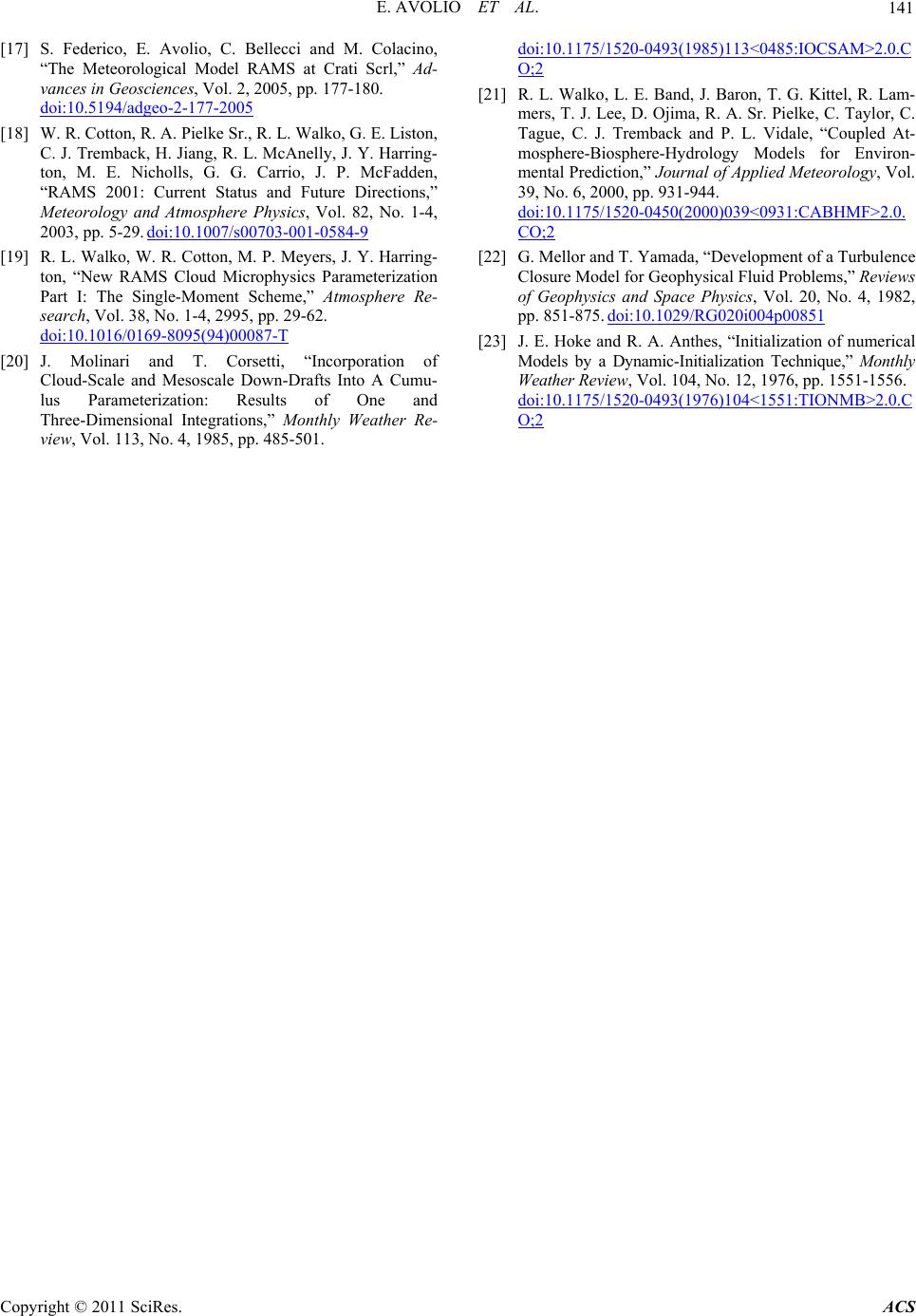 E. AVOLIO ET AL. Copyright © 2011 SciRes. ACS 141 [17] S. Federico, E. Avolio, C. Bellecci and M. Colacino, “The Meteorological Model RAMS at Crati Scrl,” Ad- vances in Geosciences, Vol. 2, 2005, pp. 177-180. doi:10.5194/adgeo-2-177-2005 [18] W. R. Cotton, R. A. Pielke Sr., R. L. Walko, G. E. Liston, C. J. Tremback, H. Jiang, R. L. McAnelly, J. Y. Harring- ton, M. E. Nicholls, G. G. Carrio, J. P. McFadden, “RAMS 2001: Current Status and Future Directions,” Meteorology and Atmosphere Physics, Vol. 82, No. 1-4, 2003, pp. 5-29. doi:10.1007/s00703-001-0584-9 [19] R. L. Walko, W. R. Cotton, M. P. Meyers, J. Y. Harring- ton, “New RAMS Cloud Microphysics Parameterization Part I: The Single-Moment Scheme,” Atmosphere Re- search, Vol. 38, No. 1-4, 2995, pp. 29-62. doi:10.1016/0169-8095(94)00087-T [20] J. Molinari and T. Corsetti, “Incorporation of Cloud-Scale and Mesoscale Down-Drafts Into A Cumu- lus Parameterization: Results of One and Three-Dimensional Integrations,” Monthly Weather Re- view, Vol. 113, No. 4, 1985, pp. 485-501. doi:10.1175/1520-0493(1985)113<0485:IOCSAM>2.0.C O;2 [21] R. L. Walko, L. E. Band, J. Baron, T. G. Kittel, R. Lam- mers, T. J. Lee, D. Ojima, R. A. Sr. Pielke, C. Taylor, C. Tague, C. J. Tremback and P. L. Vidale, “Coupled At- mosphere-Biosphere-Hydrology Models for Environ- mental Prediction,” Journal of Applied Meteorology, Vol. 39, No. 6, 2000, pp. 931-944. doi:10.1175/1520-0450(2000)039<0931:CABHMF>2.0. CO;2 [22] G. Mellor and T. Yamada, “Development of a Turbulence Closure Model for Geophysical Fluid Problems,” Reviews of Geophysics and Space Physics, Vol. 20, No. 4, 1982, pp. 851-875. doi:10.1029/RG020i004p00851 [23] J. E. Hoke and R. A. Anthes, “Initialization of numerical Models by a Dynamic-Initialization Technique,” Monthly Weather Review, Vol. 104, No. 12, 1976, pp. 1551-1556. doi:10.1175/1520-0493(1976)104<1551:TIONMB>2.0.C O;2
|